Mastering Campfire Skills: Techniques and Safety Tips


Intro
In outdoor pursuits, the ability to make a campfire is invaluable. Not only does it provide warmth and light, but it also serves as a gathering point for social interaction and culinary preparation. This article focuses on the techniques necessary for constructing an efficient and safe campfire, providing essential insights into materials and safety practices. Whether you are a beginner or a seasoned camper, understanding the fundamentals of fire-building is crucial for any outdoor enthusiast.
Understanding Woodland Ecosystems
Woodlands represent a unique blend of life forms and environmental processes. They are often complex ecosystems that support a diverse range of flora and fauna. This biodiversity is not merely a pleasant characteristic of forests; it plays a vital role in maintaining ecological balance.
Importance of Biodiversity in Forests
Biodiversity within woodland environments contributes to the resilience of ecosystems. Various species interact in intricate ways, ensuring that natural processes function optimally. When crafting a campfire, recognizing the importance of protecting these ecosystems is essential. This understanding can lead to more responsible choices regarding fire locations and materials used.
Role of Forests in Climate Regulation
Forests are often considered the lungs of our planet, absorbing carbon dioxide and releasing oxygen. They play a significant role in climate moderation. This function underscores why campfires, while beneficial for warmth and cooking, must be managed to prevent unintended consequences like wildfires. Be mindful of the location of your fire and adhere to local regulations to contribute positively to forest health.
Best Practices for Building a Campfire
Creating a campfire is more than just a simple task. It requires careful planning and knowledge of the materials involved. Here, we will explore the fundamental aspects of building a campfire efficiently and safely.
Choosing the Right Location
When selecting a site for your campfire, consider the following criteria:
- Distance from flammable materials: Ensure there are no overhanging branches or dry leaves nearby.
- Prevailing wind direction: Avoid areas where wind could carry sparks toward flammable objects.
- Accessibility of firewood: Choose a location that allows for easy access to firewood without damaging the surrounding environment.
Required Materials
When preparing to build a campfire, gather the following materials:
- Tinder: Small, dry materials that ignite easily, such as dry grass, leaves, or bark.
- Kindling: Small sticks or branches, usually no thicker than a pencil, that help to grow the fire.
- Firewood: Larger pieces of wood that will sustain the fire once it is established. Use a mix of sizes for better burning efficiency.
Step-by-Step Instructions for Building a Fire
- Prepare the fire pit: Clear a circle of at least 3 feet in diameter. Remove any debris and dig a shallow pit if needed.
- Place the tinder: In the center of your fire pit, create a small pile of tinder.
- Add kindling: Arrange kindling pieces around the tinder in a teepee shape, leaving space for airflow.
- Light the fire: Use matches or a lighter to ignite the tinder. Gently blow at the base of the flames to encourage growth.
- Add firewood gradually: Once the kindling catches, add larger pieces of wood slowly, maintaining airflow.
"A well-built campfire does not just illuminate an area; it embodies a connection to nature."
Maintaining and Extinguishing the Fire
Once the fire is established, it is vital to maintain it responsibly. Always monitor your fire's size and ensure it remains within your designated fire area.
When it is time to extinguish the fire, follow these steps:
- Let the fire burn down: Allow the fire to consume as much of the wood as possible.
- Sprinkle water: Carefully pour water onto the fire until it is completely extinguished. Stir the ashes to ensure there are no hot embers left.
- Check for heat: Place your hand above the ashes to feel for heat. Continue to add water until everything is cool to the touch.
- Leave no trace: Ensure the area is clean and free of debris. Respect nature, leaving it as you found it.
Understanding Campfires
Campfires are more than just a source of light and warmth in the wilderness. They hold significant cultural and practical importance. Understanding the fundamental aspects of campfires can greatly enhance your outdoor experience. It is crucial to appreciate their role in safety, navigation, and community building during camping activities.
Definition and Importance
A campfire is defined as an open flame or a controlled fire used outdoors, primarily for cooking, warmth, and social interactions. The importance of campfires extends beyond mere functionality. They serve as gathering places, fostering connections among people in intimate settings. This warmth can enhance camaraderie, encourage storytelling, and create lasting memories.
Furthermore, campfires can assist with navigation. When visibility is low, flames can act as beacons. They provide safety against wildlife, creating a barrier between campers and potentially unsafe encounters. Additionally, campfires can contribute to the cooking environment where enjoyable meals are prepared, demonstrating their value in various camping activities.
Historical Context
Historically, the campfire has played an integral role in human survival and community building. Fire has been a vital tool, utilized by our ancestors for heat, protection, and cooking. The ability to create and maintain a fire was a significant development that changed how early humans interacted with their environment.
In many cultures, communal fires have served as a focal point for gatherings and ceremonies. The act of sharing food prepared over a fire nurtured social bonds and exemplified cultural practices. As societies evolved, the campfire maintained its place as a symbol of resilience and unity.
In modern times, while the means to start a fire have advanced with technology, the essence of fire remains the same. It is still a powerful symbol of warmth and connection, inviting individuals to gather around, share experiences, and forge memories.
Types of Campfires
Understanding the different types of campfires is essential for any outdoor activity involving fire. Each type serves a specific purpose, offering various advantages and considerations that depend on your needs in any given situation. This knowledge assists enthusiasts and professionals alike in making informed choices regarding fire construction, ensuring safety, and enhancing the camping experience.
Cooking Fires
Cooking fires are among the most practical campfires, designed specifically for meal preparation. They need to produce consistent heat, making it easier to cook food efficiently. This type often incorporates a raised structure using stones or a grill grate, allowing for even heat distribution.
Benefits:
- They facilitate outdoor catering, adding flavor and fun to meals.
- A well-constructed cooking fire minimizes the risk of burns.
- Cooking over an open flame can impart unique tastes to food.
Considerations:
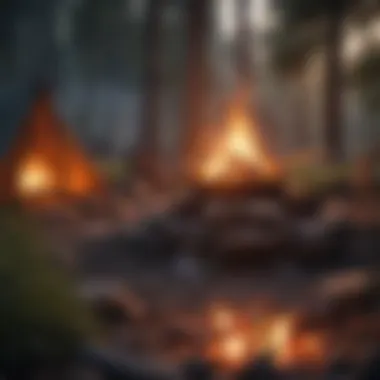
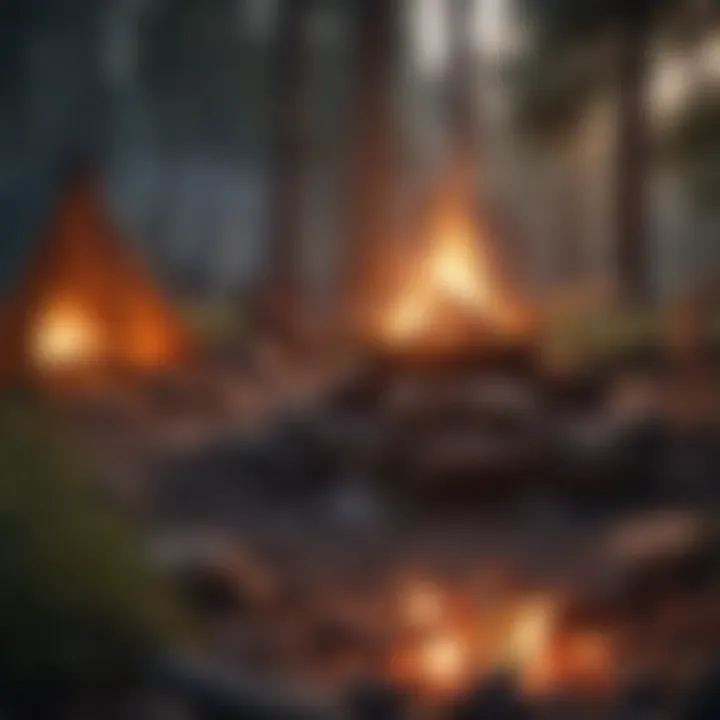
- Choose dry, seasoned wood to achieve optimal results.
- Position the fire away from tents and other flammable materials.
- Be mindful of local fire regulations, particularly in burn restrictions.
Heat Fires
Heat fires are intended primarily for warmth and comfort during chilly nights outdoors. Their construction can be more extensive compared to other types, often involving larger logs and a more focused structure. The primary focus here is to radiate heat efficiently.
Benefits:
- They provide a warm gathering place for socializing and storytelling.
- The right design can deliver heat across a wider area.
Considerations:
- Monitor the fire size to avoid safety hazards.
- Ensure that the wind direction does not blow smoke towards sleeping areas.
- Construct them in a location where they will not pose a wildfire risk.
Signal Fires
Signal fires have a specific purpose in outdoor settings, often used to attract attention or signal for help. They can be vital in emergency situations, where visibility is essential.
Benefits:
- They can be seen from a distance, effectively alerting rescuers.
- Simple to construct with available materials, they can use green foliage or other additives to produce thick smoke.
Considerations:
- Use signal fires only in emergencies; their safety is dependent on the context.
- Avoid causing panic or confusion with smoke signals in populated areas.
Recreational Fires
Recreational fires focus on enjoyment rather than specific tasks. These can range from small fires for roasting marshmallows to larger gatherings where a campfire atmosphere is desired. Their primary role is to create ambiance and a sense of community in outdoor experiences.
Benefits:
- They enhance the camping experience, providing warmth and a social hub.
- The light can deter wildlife and add to the nighttime scenery.
Considerations:
- Make sure flames are manageable throughout the night, especially if consuming alcohol.
- Pay attention to local regulations regarding open flames, particularly in high-risk fire areas.
Essential Materials for a Campfire
Creating a campfire is an essential skill for anyone who enjoys the outdoors. Understanding the essential materials needed for building a campfire ensures that your experience is safe and effective. The right materials not only enable a successful ignition but also contribute to the fire's longevity. Here, we will explore the various elements that make up the foundation of a great campfire, focusing on the benefits and considerations of each component.
Fuel Types
Wood
Wood is perhaps the most traditional and commonly used fuel for campfires. Its availability in many natural environments makes it a practical choice for many campers. The key characteristic of wood is that it burns for a long time, providing consistent heat. A major benefit of using wood is the ability to create a wide range of fire sizes, from small cooking flames to larger, warming fires. Additionally, many camping enthusiasts enjoy the aroma produced by burning different types of wood, such as cedar or maple, which can enhance the outdoor experience. However, wood requires proper preparation, such as drying and cutting, which can be a drawback for some.
Charcoal
Charcoal is another effective fuel type known for producing a hot, even heat. It is often favored for cooking, as it can maintain a consistent temperature when grilling food. The key aspect of charcoal is its efficiency; it burns longer than most types of wood. This makes it an excellent choice for those planning to cook meals outdoors. However, charcoal is more challenging to ignite than wood and may require chemical starters, which some campers prefer to avoid for environmental reasons. Its use is typically limited to designated grilling areas in parks.
Propane
Propane is a modern solution that offers convenience. It is often found in portable camping stoves and fire pits. The key characteristic of propane is that it ignites easily and provides immediate heat. Many outdoor enthusiasts appreciate its quick setup and minimal cleanup. Moreover, using propane reduces the risk of wildfires since it is easier to control than traditional wood fires. However, a significant drawback is the need to carry fuel canisters, which can become cumbersome if backpacking long distances. Also, the reliance on propane can detract from the traditional camping experience for some individuals.
Fire Starters
Matches
Matches are a classic fire starter option, widely recognized for their simplicity and effectiveness. The primary advantage of using matches is their accessibility; they are easy to carry and use. They quickly light tinder, making starting a fire straightforward, which is essential for people new to camping. Nonetheless, matches can be affected by moisture, so it is advisable to store them in a waterproof container.
Lighters
Lighters provide another reliable way to ignite a fire. Their convenience lies in their ability to produce a sustained flame with minimal effort. Lighters are efficient and can be used in varied conditions, even when it's windy. However, they also have a downside: if they run out of fuel, they become useless.
Firestarter Cubes
Firestarter cubes are manufactured products designed to ignite easily and burn steadily. They are favored for their reliability, particularly in difficult conditions, where natural materials may struggle to catch fire. The main advantage of firestarter cubes is that they provide a consistent flame, which can help igniting the larger fuel quickly. However, some may view them as less environmentally friendly compared to natural options.
Safety Gear
Gloves
Gloves are essential for protection when handling hot materials or igniting fires. They prevent burns and provide a better grip on logs and tools. The key reason to use gloves is for safety. They can be made from various materials, such as leather or synthetic materials, each with different durability levels. However, if not chosen carefully, they can limit dexterity, which may complicate preparation tasks.
Fire Extinguisher
A fire extinguisher is vital for safety, ensuring campers can act quickly if a fire becomes uncontrolled. The main benefit is its immediate ability to suppress flames, potentially preventing a disaster. It is required to be kept nearby at all times during the fire. However, the extinguisher must be maintained properly, as expired equipment may not function when needed.
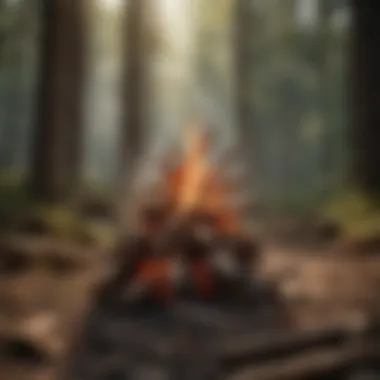
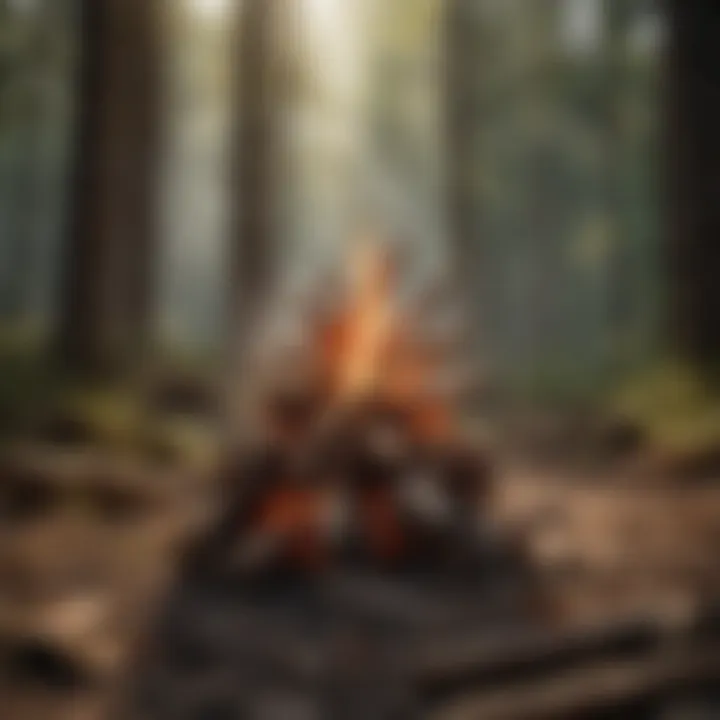
First Aid Kit
A first aid kit is a necessary precaution when engaging in outdoor activities. Accidents can happen, and having the proper supplies on hand can make a significant difference. The primary characteristic of a first aid kit is that it provides immediate support for minor injuries. It should include bandages, antiseptics, and any necessary personal medications. One disadvantage is that carrying a first aid kit may add weight, which could be a hindrance for long treks. However, the potential safety benefits far outweigh this concern.
Building a Campfire
Building a campfire is a pivotal skill for outdoor enthusiasts. It is essential not only for warmth and cooking but also serves as a vital safety feature in many wilderness settings. The act of creating a campfire involves multiple steps, including site selection, material gathering, and ignition techniques. Each of these elements plays a significant role in ensuring that the fire is safe, effective, and enjoyable.
Understanding how to build a campfire correctly can also enhance the camping experience by providing a central point for gatherings, storytelling, and relaxation. Moreover, a well-maintained campfire can prevent wildfires, as it keeps the fire contained and manageable. This section delves into the necessary steps for constructing a reliable and safe campfire.
Selecting the Site
Choosing the right location for your campfire is critical. The site should be flat, away from overhanging branches, and at least 15 feet from tents and gear. Look for a place where the wind is less likely to affect the flames. This minimizes the risk of embers blowing away and igniting unintended areas.
You should also consider proximity to water sources for easy access in case of emergency. Ideally, the ground should be bare or made of gravel to prevent the flames from spreading.
Creating a Fire Ring
A fire ring provides a physical barrier for the flames. This can be constructed using rocks or a metal fire ring designed for camping. The fire ring is essential in containing the fire and ensuring it does not spread.
When creating a fire ring, arrange rocks in a circle roughly three feet in diameter. Ensure there are gaps for ventilation, as proper airflow is necessary for a steady burn. Fire rings not only help control the fire but also add a level of safety and permanence.
Gathering Materials
Tinder
Tinder is the foundational material that ignites easily. Its primary role is to catch the initial flame and help start the fire. Popular choices for tinder include dry grass, leaves, and small twigs. One key characteristic of effective tinder is its low ignition temperature.
Natural materials work well, but you can also opt for manufactured options like cotton balls soaked in petroleum jelly. The advantage of synthetic tinder is its reliability, but it may not be as environmentally friendly.
Kindling
Kindling consists of slightly larger pieces of wood, typically pencil-sized. The purpose of kindling is to bridge the gap between the easily ignited tinder and the more substantial fuel wood. It catches fire from the tinder and then ignites the larger logs.
A key benefit of kindling is its ability to grow the fire effectively without much effort. You should always ensure that your kindling is dry. Use smaller branches or split wood for best results. The disadvantage of not having enough kindling can lead to a struggle in building a successful fire.
Fuel Wood
Fuel wood is important for sustaining the fire once it has been started. It should be larger logs, ideally seasoned, to reduce smoke and increase burn time. A good quality fuel wood ensures the campfire lasts throughout the evening or as long as needed.
When gathering fuel wood, consider the type of wood. Hardwoods, such as oak or hickory, burn longer and produce more heat. In contrast, softwoods provide quick bursts of energy but burn faster. The challenge with fuel wood is ensuring you have enough without over-collecting, which can harm local ecosystems.
The Fire Structure
Tepee Design
The Tepee design involves arranging kindling and fuel wood in a cone shape. This design encourages a strong upward draft, aiding ignition. The strategic placement allows for airflow, which is critical for combustion.
One advantage of the Tepee design is its efficient burning characteristics. However, it may collapse if not constructed correctly, disrupting the fire.
Log Cabin Design
The Log Cabin structure features logs placed in a square formation with kindling inside. This design is ideally suited for a longer-burning fire. The logs can be stacked to create multiple tiers, allowing for a consistent heat source.
However, constructing a Log Cabin type fire requires more materials and can take longer to build than other methods.
Cross-Stacking Design
Cross-Stacking involves laying logs parallel to each other, alternating their orientation. This creates gaps for airflow while providing a stable structure. The cross-stacked logs ignite gradually, allowing for a raging fire without the need for constant maintenance.
The benefit of this design is its durability, although it may require more experience to make it effective.
Ignition Techniques
Top-Down Burning
In Top-Down Burning, larger logs are placed at the bottom, with kindling and tinder at the top. This method promotes a slow burn that helps maintain heat levels.
One unique feature of this technique is minimal smoke production, making it beneficial in some wilderness areas. The challenge lies in igniting the tinder fully, as inadequate flames can lead to difficulties.
Bottom-Up Burning
Bottom-Up Burning is the traditional approach where tinder and kindling are at the bottom, and larger logs are added atop. This method produces a more immediate fire and quickly generates heat.
However, it may generate more smoke in the initiation phase, which can be undesirable in certain situations. The flames also need continuous monitoring to ensure they remain active.
Key to a successful campfire: Proper planning and execution can lead to a memorable outdoor experience.
Knowing how to build a campfire correctly ensures safety and enhances the overall enjoyment of the outdoors. It is an important skill in outdoor activities, and mastering these elements can significantly enrich the camping experience.
Maintaining the Campfire
Maintaining a campfire is an essential aspect of ensuring both safety and functionality. A well-managed fire can provide warmth, light, and a means to cook, while also serving as a gathering point for socialization in the outdoors. However, the uncontrolled fire can pose significant risks. Thus, understanding the nuances of maintaining the campfire becomes critical for any outdoor enthusiast.
Monitoring the Fire
Monitoring the fire is crucial in managing its behavior and ensuring it remains within safe boundaries. Regular checks on the flames and heat levels can prevent unwanted flare-ups or excessive smoke. It is advisable to keep an eye on the wind direction, as it can affect how embers might spread. Understanding how different phases of a fire react to natural elements is vital. For instance, if the flames become too high or if the fire starts popping excessively, it may indicate an overabundance of fuel or insufficient airflow. Always have a designated person responsible for this task to avoid distractions from the group activities.
Adding Fuel Effectively
Adding fuel to the campfire should be done thoughtfully and strategically. The choice between different fuel materials can affect both the fire's longevity and its behavior. When fuel wood is added, it is essential to follow a methodical approach. This involves placing larger logs around the perimeter while gradually adding smaller twigs or kindling as the flames strengthen. This layered approach ensures consistent heat. Keep in mind that adding too much fuel at once can suffocate the fire, causing it to dwindle instead of grow.
Controlling the Flames
Controlling the flames is an art that comes with experience. Proper airflow is important for flame regulation. To control flame height, adjustments in the arrangement of logs can be made. For example, using a tepee structure allows flames to draw air efficiently, enhancing combustion. If flames are too vigorous, consider reorganizing the logs to create more space for airflow. Additionally, using green wood should be avoided, as it can create smoke and unmanageable flames.
Effective campfire maintenance not only ensures safety but creates an enjoyable outdoor experience.
Extinguishing the Campfire
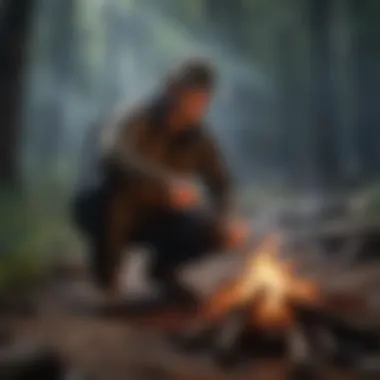
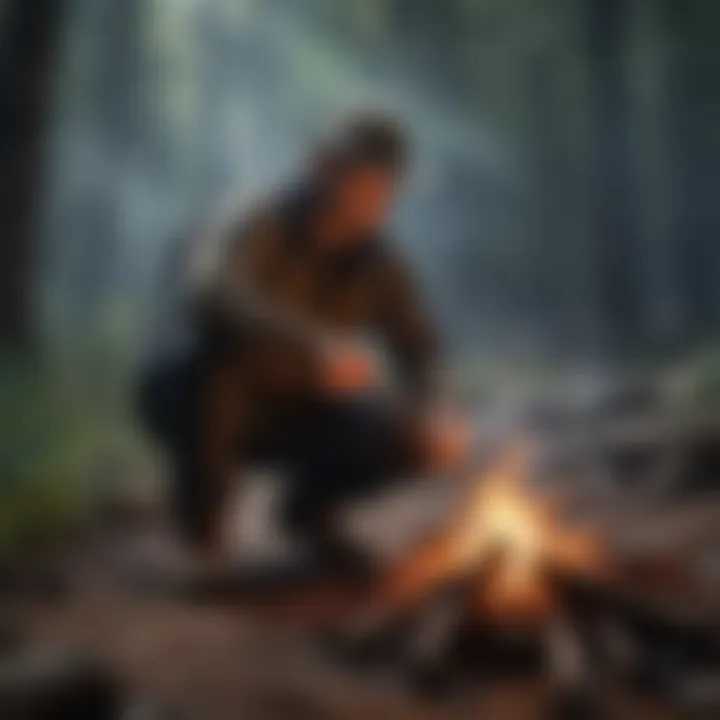
The importance of properly extinguishing a campfire cannot be overstated. It is a critical step in ensuring safety and minimizing environmental impact. A fire left unattended can spread quickly, leading to potential wildfires, which pose a significant threat to both wildlife and human life. Furthermore, it is essential for protecting natural resources and habitats. Proper extinguishing methods contribute to responsible camping practices, ensuring that future generations can enjoy the outdoors without the looming threat of fire hazards.
Proper Techniques
To effectively extinguish a campfire, follow these proper techniques:
- Let the Fire Burn Down: Allow the fire to burn until it becomes smaller and embers are visible. This can help reduce the amount of fuel that needs to be extinguished.
- Sprinkle Water: Slowly pour water over the fire, ensuring to cover all embers and ashes thoroughly. Avoid using large quantities at once to prevent steam burns or splashes.
- Stir the Ashes: Use a stick or shovel to stir the ashes and embers gently. This ensures that all heated materials are exposed to water for complete extinguishment.
- Feel for Heat: Carefully check for any remaining heat by placing the back of your hand near the ashes. If it feels warm, add more water and stir until cool.
- Repeat if Necessary: If the fire is still warm after the first round of water, repeat the process until you can be confident it is fully extinguished.
By following these steps, you effectively eliminate the risk of re-ignition while ensuring a safe campsite environment.
Post-Fire Safety Check
After the campfire has been extinguished, conduct a post-fire safety check. This final step is necessary to ensure your campsite is safe:
- Visual Inspection: Look for any glowing embers or charred materials. Visually inspect the fire ring and surrounding area.
- Soil Interaction: If possible, touch the ground where the fire was. It should be cool to the touch. If it is warm, continue to apply water.
- Ensure Surroundings are Clear: Check that no flammable materials are near the fire site. Remove any debris that may catch fire in the future.
"A responsible camper ensures that their campfire is completely out before leaving the site. It’s not just good practice; it’s a commitment to preserving the wilderness."
- Report Issues: If you notice any signs of potential fire hazards in your area, such as excessive dry materials, report them to local authorities or park rangers.
Following these processes highlights the importance of responsible camping practices while ensuring safety for all who enjoy the outdoors.
Safety Considerations
Ensuring safety when making a campfire is critical for both personal wellbeing and environmental conservation. Understanding safety considerations helps prevent accidents that can lead to injuries or wildfires. Additionally, awareness of regulations and the environment allows for responsible campfire practices. In essence, prioritizing safety ensures that outdoor experiences remain enjoyable and secure.
Local Regulations
Before starting a campfire, it is essential to consider local regulations. Many regions have specific rules regarding campfires, especially during dry seasons or in protected areas. These laws may vary from one location to another, and failure to adhere to them can result in fines or, worse, wildfires.
- Permits: In some national parks or forests, a campfire permit may be required. Always check with local authorities to ensure compliance.
- Designated Areas: Fires must often be limited to certain designated sites where risks are mitigated, and the areas can handle the use of fire.
- Fire Restrictions: During heightened fire hazards, local authorities might impose fire bans. It is crucial to follow these directives to protect the environment and the safety of all campers.
Environmental Impact
The environmental impact of campfires can be significant. If not managed properly, campfires can contribute to deforestation, habitat destruction, and increased smoke pollution. By understanding these effects, one can make informed decisions regarding campfire practices.
- Burn Damage: An uncontrolled fire can lead to damage in the surrounding forest and wildlife habitats. Using existing fire rings can minimize this impact.
- Debris: Burning debris can release harmful pollutants into the air. It is advisable to use clean, dry wood and avoid burning treated or painted materials.
- Wildlife Disruption: Campfires can disturb local wildlife, affecting their habits and habitats. Maintaining a safe distance from animal trails and nesting sites can minimize this disruption.
Proper campfire management is not only a safety concern, but it is also vital for the preservation of natural ecosystems.
The responsibility lies with every camper to ensure fire safety and protect the environment for future generations.
Cultural Significance of Campfires
Campfires serve more than the basic function of providing warmth and light. They symbolize a gathering point, fostering human connection and interaction. The allure of a crackling fire draws people in, creating a space for sharing stories, laughter, and even silence—a space for reflection. Understanding the cultural significance of campfires enhances our appreciation for this age-old practice in both historical and modern contexts.
Campfires in Human History
Throughout history, campfires have played a pivotal role in human survival and social structure. Early humans relied on fires for warmth and protection against predators. As societies evolved, so did the ways campfires were utilized. They became an essential aspect of communal life.
In ancient cultures, campfires were central to rituals and ceremonies. The fire often represented a connection between the living and the spiritual world. For many indigenous people, fire holds a sacred significance. It is used in customs that reflect their values and beliefs. The stories told around campfires often come with moral lessons—teaching about nature, community, and existence itself.
The social structure of communities often revolved around the campfire. It was a place for gathering, where wisdom was passed down through generations. Campfires facilitated discussions about daily life, challenges, and celebrations. In this sense, campfires can be seen as a catalyst for community bonding.
Modern Uses of Campfires
Today, campfires continue to hold a special place in outdoor culture, served both recreational and practical purposes. Modern campers view campfires as a way to escape the busy pace of life, allowing for quiet contemplation or spirited conversation among friends and family.
Additionally, campfires are often used in camping activities such as cooking. They serve as a method to prepare meals in a rustic style, enhancing the experience of outdoor living. Cooking over an open flame can evoke a deeper connection to nature and a sense of achievement.
With the rise of eco-tourism and sustainability, campfires have also spawned discussions on responsible use. This includes understanding local regulations, minimizing environmental impact, and ensuring safety. Campfires are reemerging as valuable tools not just for leisure, but also for sustaining connections with nature and tradition.
"The campfire remains a bridge connecting our past to our present, fostering tradition and community while reminding us of our elemental roots."
In summary, the cultural significance of campfires is multidimensional, stretching beyond mere functionality. They encompass rich historical values while adapting to contemporary uses. This duality makes the campfire a enduring symbol of human connection, resilience, and natural harmony.
Closure
In this article, we have explored the extensive topic of campfires, highlighting their significance, types, and essential techniques. Understanding campfires is more than just kindling a flame. It encompasses knowledge of safe practices and the appropriate setup for different scenarios.
A well-built campfire can provide warmth, facilitate cooking, and offer a gathering space in outdoor settings. Yet, the importance of safety cannot be overstated. Following local regulations and respecting the environment is crucial in preserving the natural landscape for future generations.
Additionally, the cultural relevance of campfires in human history speaks to their enduring role in communal experiences. They create moments of bonding and storytelling, fostering connections among people.
By mastering the construction, maintenance, and extinguishment of campfires, outdoor enthusiasts can deepen their appreciation for nature while ensuring a responsible experience. Key considerations include:
- Proper site selection
- Maintaining awareness of fire conditions
- Understanding the environmental impact of fires
The collective takeaway from this exploration should be a recognition of the skill involved in managing campfires. Competence in this area translates to safer, more enjoyable outdoor experiences.
Key Takeaways
- Understanding Campfires: Their significance extends beyond practicality. They are central to many cultural traditions and aspects of outdoor comfort.
- Types of Campfires: Different types serve various purposes. Knowing which type to use can significantly enhance your outdoor experience.
- Building Techniques: Techniques like proper site selection and fire structure can ensure a safe and effective campfire.
- Safety Practices: Following guidelines for safety and environmental impact is vital for responsible outdoor activity.
- Cultural Connections: Campfires foster community and connection, serving as a backdrop to many human experiences.
These elements weave together to form a comprehensive understanding of not just how to make a campfire, but also why we do it. Engaging with the natural world through this essential skill is both an art and a science, making it a valuable topic for forestry professionals and the academically minded.







